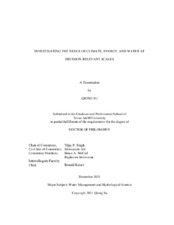| dc.contributor.advisor | Singh, Vijay p. | |
| dc.contributor.advisor | Ale, Srinivasulu | |
| dc.creator | Su, Qiong | |
| dc.date.accessioned | 2022-07-27T16:41:09Z | |
| dc.date.available | 2023-12-01T09:23:20Z | |
| dc.date.created | 2021-12 | |
| dc.date.issued | 2021-12-06 | |
| dc.date.submitted | December 2021 | |
| dc.identifier.uri | https://hdl.handle.net/1969.1/196353 | |
| dc.description.abstract | Providing reliable and sustainable energy and water service faces multiple challenges, including increasing demand due to population growth and economic development, degradation of water resources, depletion of fossil energy resources as well as climate change. To mitigate climate change impacts, many countries have announced their Nationally Determined Contributions (NDC) in the Paris Agreement to reduce carbon dioxide (CO₂) emissions. Water and energy systems are interdependent and have complex dynamic interactions with the socio-economic system and climate change. Policies and measures designed to increase the efficiency in one system might significantly affect the other. This dissertation developed an integrated model to simulate the interactions among socioeconomics, energy consumption, water use, water infrastructure, and receiving water systems, and to identify cost-effective solutions to meet the water and energy demands under different economic development pathways and climate futures. The dissertation includes two major parts. Part I developed and evaluated an integrated model to simulate the carbon-energy-water nexus in urbanized regions by integrating a computable general equilibrium (CGE) model and the System Dynamics and Water Environmental Model (SyDWEM), i.e., CGE-SyDWEM. The integrated model can be used to aid policymakers in energy, carbon, and water sectors to understand the complicated synergistic effects of proposed carbon mitigation strategies and water engineering measures on local/regional energy consumption, CO₂ emissions, water resources balance, and water-environment change. Part II improved the integrated model in simulating agricultural water demand and evaluating agricultural adaptation strategies to climate change, including (1) improving the representation of the agricultural water demand module in CGE-SyDWEM by assessing several less data-intensive reference evapotranspiration models for regional irrigation water demand estimation; (2) improving the seasonal weather forecasts for real-time regional crop modeling and irrigation scheduling; and (3) reducing the uncertainty in the estimation of Crop Water Stress Index (CWSI) which is used to develop water-stress-based deficit irrigation strategies for enhancing water use efficiency, thereby conserving water resources in agricultural production. | |
| dc.format.mimetype | application/pdf | |
| dc.language.iso | en | |
| dc.subject | Water-Energy Nexus | |
| dc.subject | Carbon Mitigation | |
| dc.subject | Reference Evapotranspiration | |
| dc.subject | Irrigation Water Management | |
| dc.subject | Seasonal Weather Forecast | |
| dc.subject | Crop Water Stress Index | |
| dc.title | Investigating the Nexus of Climate, Energy, and Water at Decision-Relevant Scales | |
| dc.type | Thesis | |
| thesis.degree.department | Water Management and Hydrological Science | |
| thesis.degree.discipline | Water Management and Hydrological Science | |
| thesis.degree.grantor | Texas A&M University | |
| thesis.degree.name | Doctor of Philosophy | |
| thesis.degree.level | Doctoral | |
| dc.contributor.committeeMember | McCarl, Bruce A. | |
| dc.contributor.committeeMember | Srinivasan, Raghavan | |
| dc.type.material | text | |
| dc.date.updated | 2022-07-27T16:41:09Z | |
| local.embargo.terms | 2023-12-01 | |
| local.etdauthor.orcid | 0000-0003-2420-5898 | |


